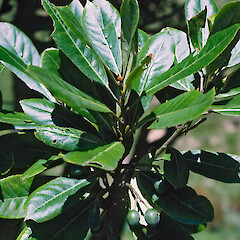Elaeocarpus dentatus var. dentatus
Common name
hīnau
Synonyms
Dicera dentata J.R.Forst. et G.Forst., Elaeocarpus hinau A.Cunn., Elaeocarpus cunninghamii Raoul
Family
Elaeocarpaceae
Flora category
Vascular – Native
Endemic taxon
Yes
Endemic genus
No
Endemic family
No
Structural class
Trees & Shrubs - Dicotyledons
NVS code
The National Vegetation Survey (NVS) Databank is a physical archive and electronic databank containing records of over 94,000 vegetation survey plots - including data from over 19,000 permanent plots. NVS maintains a standard set of species code abbreviations that correspond to standard scientific plant names from the Ngä Tipu o Aotearoa - New Zealand Plants database.
ELADEN
Chromosome number
2n = 30
Current conservation status
The conservation status of all known New Zealand vascular plant taxa at the rank of species and below were reassessed in 2017 using the New Zealand Threat Classification System (NZTCS) – more information about this can be found on the NZTCS website. This report includes a statistical summary and brief notes on changes since 2012 and replaces all previous NZTCS lists for vascular plants.
Please note, threat classifications are often suggested by authors when publications fall between NZTCS assessment periods – an interim threat classification status has not been assessed by the NZTCS panel.
- Conservation status of New Zealand indigenous vascular plants, 2017 . 2018. Peter J. de Lange, Jeremy R. Rolfe, John W. Barkla, Shannel P. Courtney, Paul D. Champion, Leon R. Perrie, Sarah M. Beadel, Kerry A. Ford, Ilse Breitwieser, Ines Schönberger, Rowan Hindmarsh-Walls, Peter B. Heenan and Kate Ladley. Department of Conservation. Source: NZTCS and licensed by DOC for reuse under the Creative Commons Attribution 4.0 International licence.
2017 | Not Threatened
Previous conservation statuses
2012 | Not Threatened
2009 | Not Threatened
2004 | Not Threatened
Brief description
Canopy tree bearing harsh thin leaves that have obvious pits on the underside and with small teeth along margins. Twigs with small hairs. Adult leaves 10-12cm long by 2-3cm wide, with a sharp tip, Juvenile leaves narrower. Flowers white, lacy, in conspicuous sprays. Fruit purple, oval, 12-15mm long.
Distribution
Endemic. North, and South Island as far South Westland in the west and Christchurch in the east.
Habitat
Common tree of mainly coastal and lowland forest though occasionally extending into montane forest.
Detailed description
Tree up to 20 m tall (usually less), with broad spreading crown. Trunk 1 m diam., bark grey. Branches erect then spreading, branchlets silky hairy when young. Petioles stout, 20-25 mm long. Leaves leathery, (50-)100-120 x 20-30 mm, narrow- to obovate-oblong, broad-obovate, oblanceolate, apex obtuse or abruptly acuminate, dark green and glabrescent above, off-white, silky-hairy below; margins somewhat sinuate, recurved, serrate to subentire. Inflorescence a raceme 100-180 mm long, 8-12(-20)-flowered. Pedicels 10 mm long, silky-hairy. Flowers drooping, (8-)12(-15) mm diam., sepals lanceolate-oblong, 6 mm long, petals white, obovate-cuneate, 3-5-lobed, c. 10 mm long. Stamens 10-20. Fruit a fleshy, ovoid purple-black 12-18 x 9 mm, drupe. Endocarp deeply furrowed and wrinkled.
Similar taxa
A distinctive tree easily recognised by the erecto-patent leathery bicoloured leaves, white “lily of the valley” like flowers, and small ovoid purple-black drupes. Distinguished from the closely allied pokaka by the lack of a filiramulate, divaricating juvenile and sub adult growth form, and larger leaves, flowers and fruits. The status of Elaeocarpus dentatus var. obovatus Cheeseman accepted by the New Zealand Flora, but not by Druce (1993) needs further investigation. In its typical form this variety seems very distinctive, and pending further study it is retained here, especially as no one has undertaken a modern revision of New Zealand Elaeocarpus.
Flowering
October - February
Flower colours
White
Fruiting
December - May(-June)
Life cycle
Thorsen, M. J.; Dickinson, K. J. M.; Seddon, P. J. 2009. Seed dispersal systems in the New Zealand flora. Perspectives in Plant Ecology, Evolution and Systematics 11: 285-309
Propagation technique
Easy from fresh fruit - though can be slow to germinate. Moderately easy in most soils, light and moisture regimes. However, does best in a deep, moist, well mulched soil.
Etymology
elaeocarpus: Olive-seed
dentatus: Toothed
Where To Buy
A beautiful tree which should be more widely grown. Makes an excellent specimen tree and should be more widely used in street plantings. Occasionally available from commercial and specialist native plant nurseries.
Attribution
Fact sheet prepared for NZPCN by P.J. de Lange (4 April 2007). Description adapted from Allan (1961).
References and further reading
Allan, H.H. 1961: Flora of New Zealand. Vol. I. Wellington, Government Printer.
Druce, A.P. 1993: Indigenous vascular plants of New Zealand. Ninth Revision. Unpublished Checklist held at Landcare Research, Lincoln, New Zealand.
Thorsen, M. J.; Dickinson, K. J. M.; Seddon, P. J. 2009. Seed dispersal systems in the New Zealand flora. Perspectives in Plant Ecology, Evolution and Systematics 11: 285-309
NZPCN Fact Sheet citation
Please cite as: de Lange, P.J. (Year at time of access): Elaeocarpus dentatus var. dentatus Fact Sheet (content continuously updated). New Zealand Plant Conservation Network. https://www.nzpcn.org.nz/flora/species/elaeocarpus-dentatus-var-dentatus/ (Date website was queried)





















